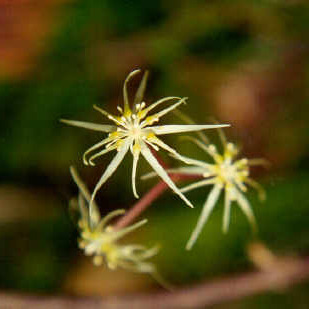Herbs perennial, rhizomatous or sometimes stoloniferous. Rhizomes branched. Leaves several, basal, long petiolate, 3-or 5-sect. Scapes 1 to several, erect. Inflorescences terminal, monochasial, 1-to few flowered. Flowers small, actinomorphic, bisexual. Sepals 5(--8), white or greenish yellow, often petaloid. Petals 5--10 or more, clawed, adaxially often nectariferous. Stamens numerous, glabrous; filaments filiform; anthers broadly elliptic. Pistils 8--14, stipitate; ovules several per ovary. Styles recurved. Follicles stipitate, oblong, transverse veins inconspicuous; persistent styles short. Seeds brown, ellipsoid, shiny, nearly smooth.
Sep 4–7, petaloid; pet none; staminodes 4–7, smaller than the sep, clavate, nectariferous in the hollow summit; stamens numerous, with broad anthers; pistils 3–7, stipitate even at anthesis, narrowed to a short, slender, persistent style; fr follicular; perennial herbs with basal, evergreen, ternately compound lvs and erect, lfless or minutely bracteate scapes with 1–few white fls. 10, N. Temp. and Arctic.

